radiator cap NISSAN X-TRAIL 2003 Electronic Service Manual
[x] Cancel search | Manufacturer: NISSAN, Model Year: 2003, Model line: X-TRAIL, Model: NISSAN X-TRAIL 2003Pages: 3066, PDF Size: 51.47 MB
Page 1884 of 3066
![NISSAN X-TRAIL 2003 Electronic Service Manual EC-770
[YD]
DTC P1217 OVERHEAT (COOLING SYSTEM)
5.DETECT MALFUNCTIONING PART
Check the following.
lHarness connectors E64, F5
lHarness for open or short between cooling fan relays-2 and -3 and ECM
>> NISSAN X-TRAIL 2003 Electronic Service Manual EC-770
[YD]
DTC P1217 OVERHEAT (COOLING SYSTEM)
5.DETECT MALFUNCTIONING PART
Check the following.
lHarness connectors E64, F5
lHarness for open or short between cooling fan relays-2 and -3 and ECM
>>](/img/5/57402/w960_57402-1883.png)
EC-770
[YD]
DTC P1217 OVERHEAT (COOLING SYSTEM)
5.DETECT MALFUNCTIONING PART
Check the following.
lHarness connectors E64, F5
lHarness for open or short between cooling fan relays-2 and -3 and ECM
>> Repair open circuit or short to ground or short to power in harness or connectors.
6.CHECK COOLING FAN RELAYS-2 AND -3
Refer toEC-771, "
Component Inspection".
OK or NG
OK >> GO TO 7.
NG >> Replace cooling fan relays.
7.CHECK COOLING FAN MOTORS
Refer toEC-771, "
Component Inspection".
OK or NG
OK >> GO TO 8.
NG >> Replace cooling fan motors.
8.CHECK INTERMITTENT INCIDENT
PerformEC-699, "
TROUBLE DIAGNOSIS FOR INTERMITTENT INCIDENT".
>>INSPECTION END
Main 12 Causes of OverheatingEBS004QY
Engine Step Inspection item Equipment Condition Reference page
OFF 1
lBlocked radiator
lBlocked radiator grille
lBlocked bumper
lVisual No blocking —
2
lCoolant mixturelCoolant tester 50 - 50% coolant mixture SeeMA-17, "RECOM-
MENDED FLUIDS AND
LUBRICANTS".
3
lCoolant levellVisual Coolant up to MAX level
in reservoir tank and radi-
ator filler neckSeeMA-27, "Changing
Engine Coolant".
4
lRadiator caplPressure tester 78 - 98 kPa (0.78 - 0.98
bar, 0.8 - 1.0 kg/cm2,11-
14 psi)SeeCO-34, "
Checking
Radiator Cap".
ON*
25lCoolant leakslVisual No leaks SeeCO-30, "LEAK
CHECK".
ON*
26lThermostatlTouch the upper and
lower radiator hosesBoth hoses should be hot SeeCO-42, "THERMO-
STAT AND WATER PIP-
ING".
ON*
17lCooling fanlCONSULT-II Operating See Trouble Diagnosis for
DTC P1217,EC-713
.
OFF 8
lCombustion gas leaklColor checker chemi-
cal tester 4 Gas ana-
lyzerNegative —
Page 2257 of 3066
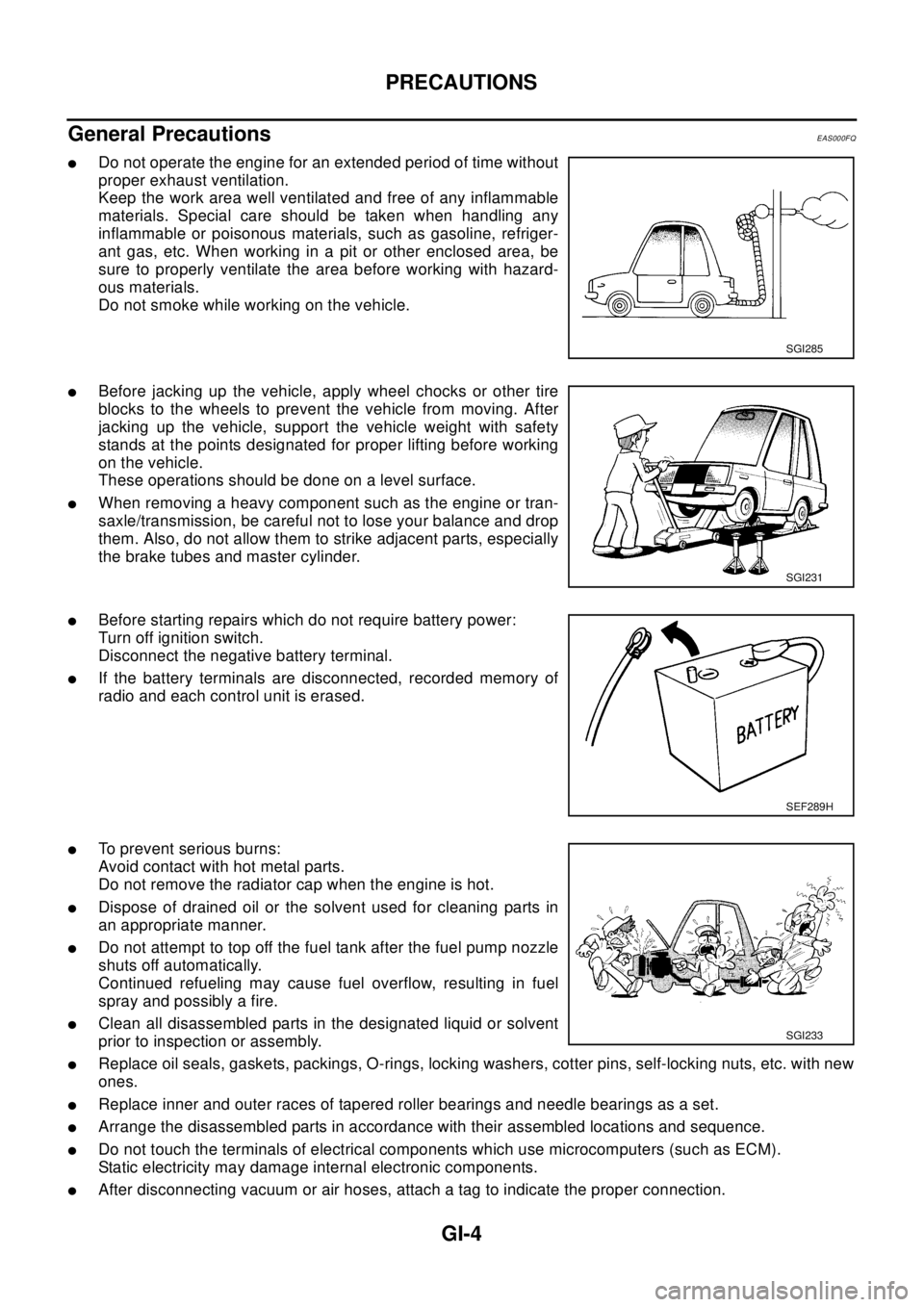
GI-4
PRECAUTIONS
General Precautions
EAS000FQ
lDo not operate the engine for an extended period of time without
proper exhaust ventilation.
Keep the work area well ventilated and free of any inflammable
materials. Special care should be taken when handling any
inflammable or poisonous materials, such as gasoline, refriger-
ant gas, etc. When working in a pit or other enclosed area, be
sure to properly ventilate the area before working with hazard-
ous materials.
Do not smoke while working on the vehicle.
lBefore jacking up the vehicle, apply wheel chocks or other tire
blocks to the wheels to prevent the vehicle from moving. After
jacking up the vehicle, support the vehicle weight with safety
stands at the points designated for proper lifting before working
on the vehicle.
These operations should be done on a level surface.
lWhen removing a heavy component such as the engine or tran-
saxle/transmission, be careful not to lose your balance and drop
them. Also, do not allow them to strike adjacent parts, especially
the brake tubes and master cylinder.
lBefore starting repairs which do not require battery power:
Turn off ignition switch.
Disconnect the negative battery terminal.
lIf the battery terminals are disconnected, recorded memory of
radio and each control unit is erased.
lTo prevent serious burns:
Avoid contact with hot metal parts.
Do not remove the radiator cap when the engine is hot.
lDispose of drained oil or the solvent used for cleaning parts in
an appropriate manner.
lDo not attempt to top off the fuel tank after the fuel pump nozzle
shuts off automatically.
Continued refueling may cause fuel overflow, resulting in fuel
spray and possibly a fire.
lClean all disassembled parts in the designated liquid or solvent
prior to inspection or assembly.
lReplace oil seals, gaskets, packings, O-rings, locking washers, cotter pins, self-locking nuts, etc. with new
ones.
lReplace inner and outer races of tapered roller bearings and needle bearings as a set.
lArrange the disassembled parts in accordance with their assembled locations and sequence.
lDo not touch the terminals of electrical components which use microcomputers (such as ECM).
Static electricity may damage internal electronic components.
lAfter disconnecting vacuum or air hoses, attach a tag to indicate the proper connection.
SGI285
SGI231
SEF289H
SGI233
Page 2493 of 3066
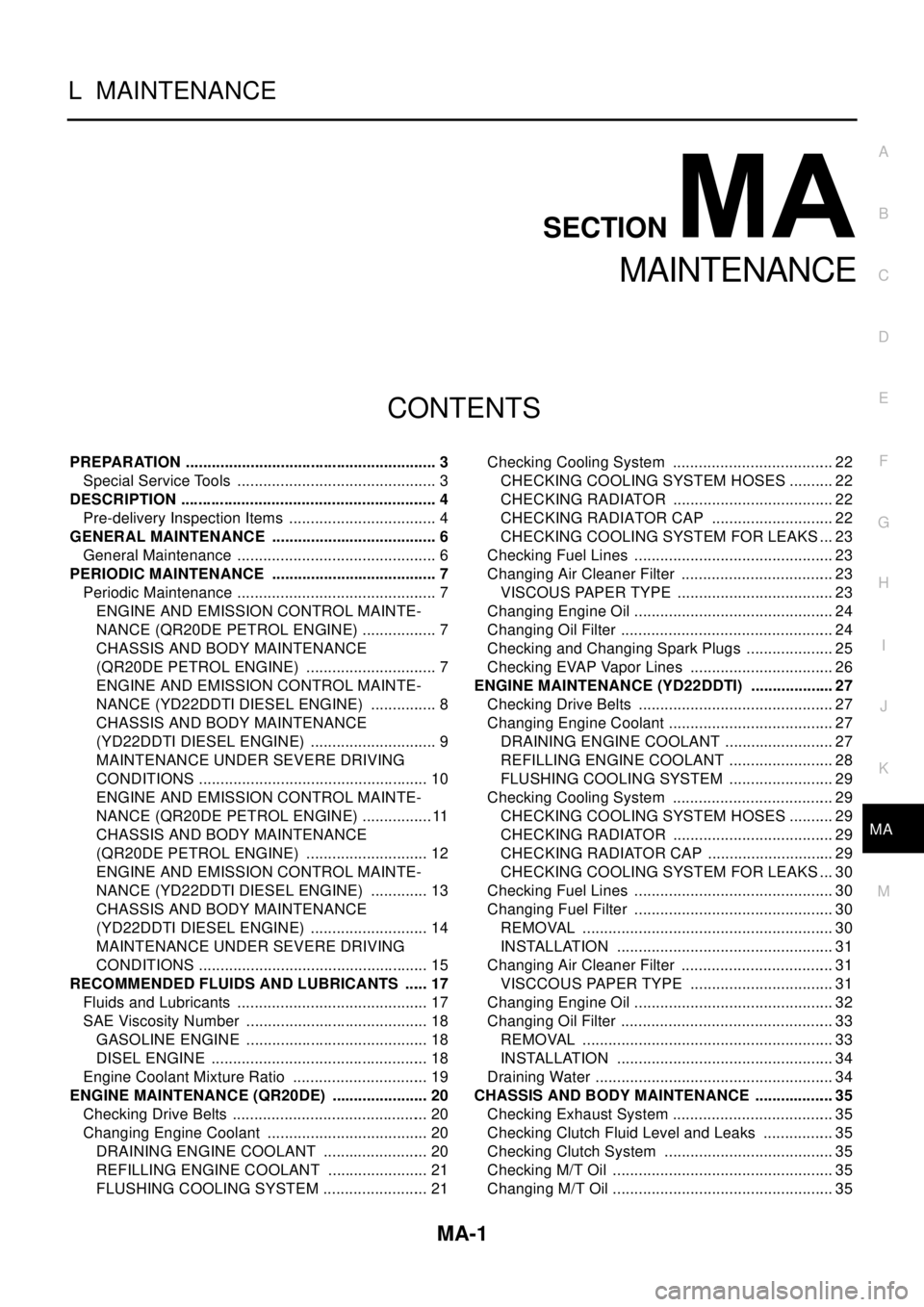
MA-1
MAINTENANCE
L MAINTENANCE
CONTENTS
C
D
E
F
G
H
I
J
K
M
SECTION
A
B
MA
MAINTENANCE
PREPARATION ........................................................... 3
Special Service Tools ............................................... 3
DESCRIPTION ............................................................ 4
Pre-delivery Inspection Items ................................... 4
GENERAL MAINTENANCE ....................................... 6
General Maintenance ............................................... 6
PERIODIC MAINTENANCE ....................................... 7
Periodic Maintenance ............................................... 7
ENGINE AND EMISSION CONTROL MAINTE-
NANCE (QR20DE PETROL ENGINE) .................. 7
CHASSIS AND BODY MAINTENANCE
(QR20DE PETROL ENGINE) ............................... 7
ENGINE AND EMISSION CONTROL MAINTE-
NANCE (YD22DDTI DIESEL ENGINE) ................ 8
CHASSIS AND BODY MAINTENANCE
(YD22DDTI DIESEL ENGINE) .............................. 9
MAINTENANCE UNDER SEVERE DRIVING
CONDITIONS ...................................................... 10
ENGINE AND EMISSION CONTROL MAINTE-
NANCE (QR20DE PETROL ENGINE) .................11
CHASSIS AND BODY MAINTENANCE
(QR20DE PETROL ENGINE) ............................. 12
ENGINE AND EMISSION CONTROL MAINTE-
NANCE (YD22DDTI DIESEL ENGINE) .............. 13
CHASSIS AND BODY MAINTENANCE
(YD22DDTI DIESEL ENGINE) ............................ 14
MAINTENANCE UNDER SEVERE DRIVING
CONDITIONS ...................................................... 15
RECOMMENDED FLUIDS AND LUBRICANTS ...... 17
Fluids and Lubricants ............................................. 17
SAE Viscosity Number ........................................... 18
GASOLINE ENGINE ........................................... 18
DISEL ENGINE ................................................... 18
Engine Coolant Mixture Ratio ................................ 19
ENGINE MAINTENANCE (QR20DE) ....................... 20
Checking Drive Belts .............................................. 20
Changing Engine Coolant ...................................... 20
DRAINING ENGINE COOLANT ......................... 20
REFILLING ENGINE COOLANT ........................ 21
FLUSHING COOLING SYSTEM ......................... 21Checking Cooling System ...................................... 22
CHECKING COOLING SYSTEM HOSES ........... 22
CHECKING RADIATOR ...................................... 22
CHECKING RADIATOR CAP ............................. 22
CHECKING COOLING SYSTEM FOR LEAKS ... 23
Checking Fuel Lines ............................................... 23
Changing Air Cleaner Filter .................................... 23
VISCOUS PAPER TYPE ..................................... 23
Changing Engine Oil ............................................... 24
Changing Oil Filter .................................................. 24
Checking and Changing Spark Plugs ..................... 25
Checking EVAP Vapor Lines .................................. 26
ENGINE MAINTENANCE (YD22DDTI) .................... 27
Checking Drive Belts .............................................. 27
Changing Engine Coolant ....................................... 27
DRAINING ENGINE COOLANT .......................... 27
REFILLING ENGINE COOLANT ......................... 28
FLUSHING COOLING SYSTEM ......................... 29
Checking Cooling System ...................................... 29
CHECKING COOLING SYSTEM HOSES ........... 29
CHECKING RADIATOR ...................................... 29
CHECKING RADIATOR CAP .............................. 29
CHECKING COOLING SYSTEM FOR LEAKS ... 30
Checking Fuel Lines ............................................... 30
Changing Fuel Filter ............................................... 30
REMOVAL ........................................................... 30
INSTALLATION ................................................... 31
Changing Air Cleaner Filter .................................... 31
VISCCOUS PAPER TYPE .................................. 31
Changing Engine Oil ............................................... 32
Changing Oil Filter .................................................. 33
REMOVAL ........................................................... 33
INSTALLATION ................................................... 34
Draining Water ........................................................ 34
CHASSIS AND BODY MAINTENANCE ................... 35
Checking Exhaust System ...................................... 35
Checking Clutch Fluid Level and Leaks ................. 35
Checking Clutch System ........................................ 35
Checking M/T Oil .................................................... 35
Changing M/T Oil .................................................... 35
Page 2511 of 3066
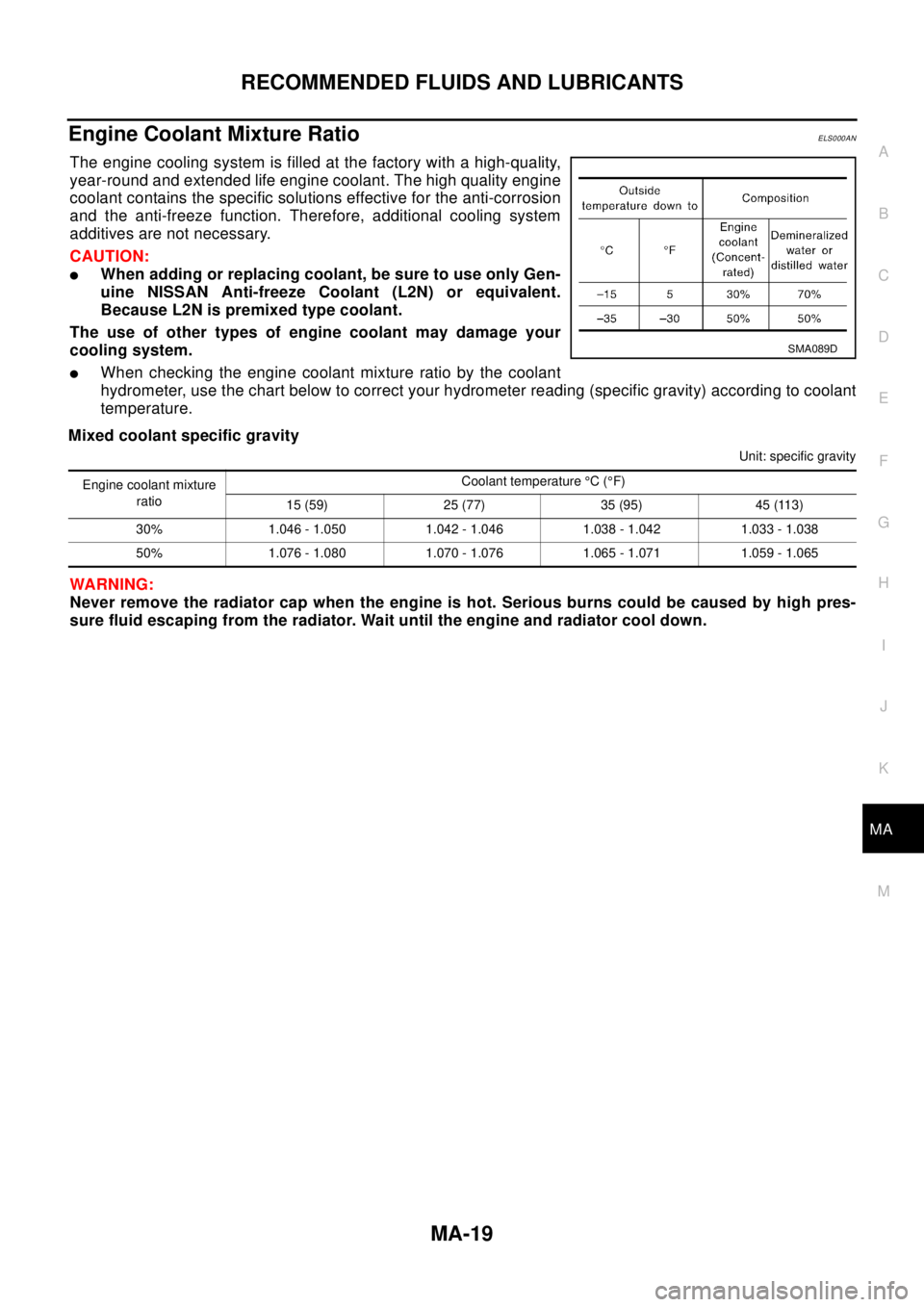
RECOMMENDED FLUIDS AND LUBRICANTS
MA-19
C
D
E
F
G
H
I
J
K
MA
B
MA
Engine Coolant Mixture RatioELS000AN
The engine cooling system is filled at the factory with a high-quality,
year-round and extended life engine coolant. The high quality engine
coolant contains the specific solutions effective for the anti-corrosion
and the anti-freeze function. Therefore, additional cooling system
additives are not necessary.
CAUTION:
lWhen adding or replacing coolant, be sure to use only Gen-
uine NISSAN Anti-freeze Coolant (L2N) or equivalent.
Because L2N is premixed type coolant.
The use of other types of engine coolant may damage your
cooling system.
lWhen checking the engine coolant mixture ratio by the coolant
hydrometer, use the chart below to correct your hydrometer reading (specific gravity) according to coolant
temperature.
Mixed coolant specific gravity
Unit: specific gravity
WA RN ING:
Never remove the radiator cap when the engine is hot. Serious burns could be caused by high pres-
sure fluid escaping from the radiator. Wait until the engine and radiator cool down.
SMA089D
Engine coolant mixture
ratioCoolant temperature°C(°F)
15 (59) 25 (77) 35 (95) 45 (113)
30% 1.046 - 1.050 1.042 - 1.046 1.038 - 1.042 1.033 - 1.038
50% 1.076 - 1.080 1.070 - 1.076 1.065 - 1.071 1.059 - 1.065
Page 2512 of 3066
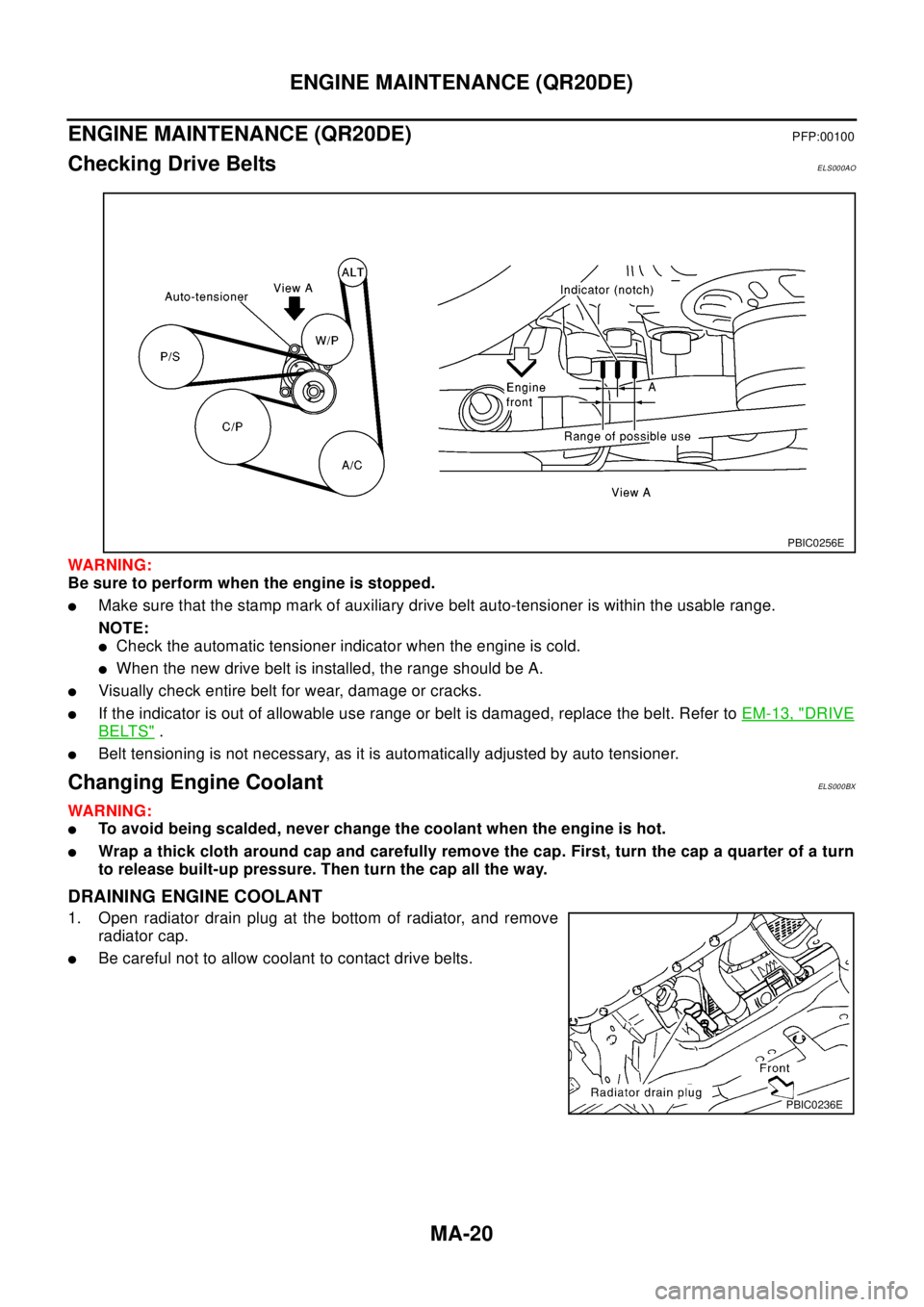
MA-20
ENGINE MAINTENANCE (QR20DE)
ENGINE MAINTENANCE (QR20DE)
PFP:00100
Checking Drive BeltsELS000AO
WAR NIN G:
Be sure to perform when the engine is stopped.
lMake sure that the stamp mark of auxiliary drive belt auto-tensioner is within the usable range.
NOTE:
lCheck the automatic tensioner indicator when the engine is cold.
lWhen the new drive belt is installed, the range should be A.
lVisually check entire belt for wear, damage or cracks.
lIf the indicator is out of allowable use range or belt is damaged, replace the belt. Refer toEM-13, "DRIVE
BELTS".
lBelt tensioning is not necessary, as it is automatically adjusted by auto tensioner.
Changing Engine CoolantELS000BX
WAR NIN G:
lTo avoid being scalded, never change the coolant when the engine is hot.
lWrap a thick cloth around cap and carefully remove the cap. First, turn the cap a quarter of a turn
to release built-up pressure. Then turn the cap all the way.
DRAINING ENGINE COOLANT
1. Open radiator drain plug at the bottom of radiator, and remove
radiator cap.
lBe careful not to allow coolant to contact drive belts.
PBIC0256E
PBIC0236E
Page 2513 of 3066
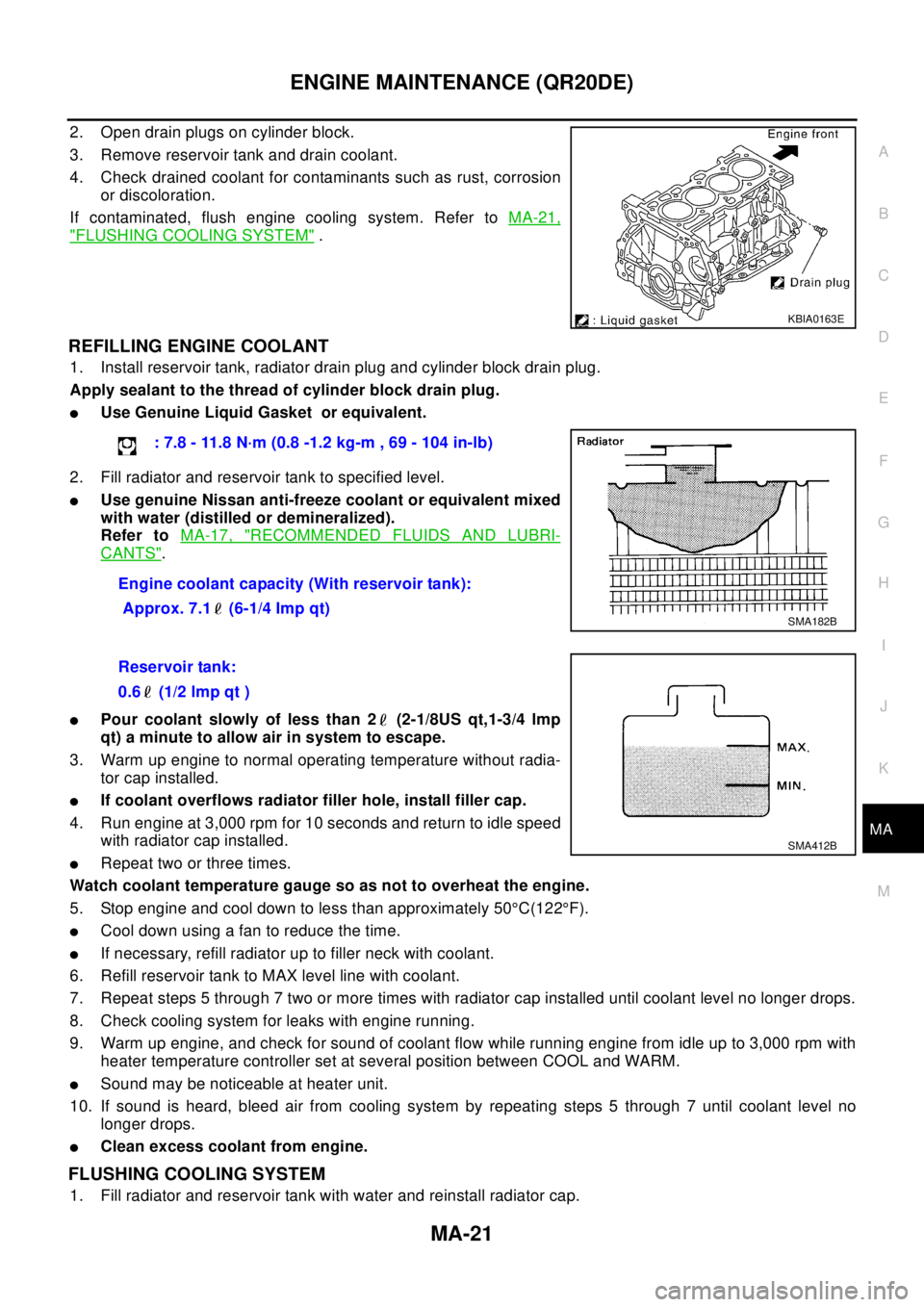
ENGINE MAINTENANCE (QR20DE)
MA-21
C
D
E
F
G
H
I
J
K
MA
B
MA
2. Open drain plugs on cylinder block.
3. Remove reservoir tank and drain coolant.
4. Check drained coolant for contaminants such as rust, corrosion
or discoloration.
If contaminated, flush engine cooling system. Refer toMA-21,
"FLUSHING COOLING SYSTEM".
REFILLING ENGINE COOLANT
1. Install reservoir tank, radiator drain plug and cylinder block drain plug.
Apply sealant to the thread of cylinder block drain plug.
lUse Genuine Liquid Gasket or equivalent.
2. Fill radiator and reservoir tank to specified level.
lUse genuine Nissan anti-freeze coolant or equivalent mixed
with water (distilled or demineralized).
Refer toMA-17, "
RECOMMENDED FLUIDS AND LUBRI-
CANTS".
lPour coolant slowly of less than 2 (2-1/8US qt,1-3/4 lmp
qt) a minute to allow air in system to escape.
3. Warm up engine to normal operating temperature without radia-
tor cap installed.
lIf coolant overflows radiator filler hole, install filler cap.
4. Run engine at 3,000 rpm for 10 seconds and return to idle speed
with radiator cap installed.
lRepeat two or three times.
Watch coolant temperature gauge so as not to overheat the engine.
5. Stop engine and cool down to less than approximately 50°C(122°F).
lCool down using a fan to reduce the time.
lIf necessary, refill radiator up to filler neck with coolant.
6. Refill reservoir tank to MAX level line with coolant.
7. Repeat steps 5 through 7 two or more times with radiator cap installed until coolant level no longer drops.
8. Check cooling system for leaks with engine running.
9. Warm up engine, and check for sound of coolant flow while running engine from idle up to 3,000 rpm with
heater temperature controller set at several position between COOL and WARM.
lSound may be noticeable at heater unit.
10. If sound is heard, bleed air from cooling system by repeating steps 5 through 7 until coolant level no
longer drops.
lClean excess coolant from engine.
FLUSHING COOLING SYSTEM
1. Fill radiator and reservoir tank with water and reinstall radiator cap.
KBIA0163E
: 7.8 - 11.8 N·m (0.8 -1.2 kg-m , 69 - 104 in-lb)
Engine coolant capacity (With reservoir tank):
Approx. 7.1 (6-1/4 Imp qt)
SMA182B
Reservoir tank:
0.6 (1/2 lmp qt )
SMA412B
Page 2514 of 3066
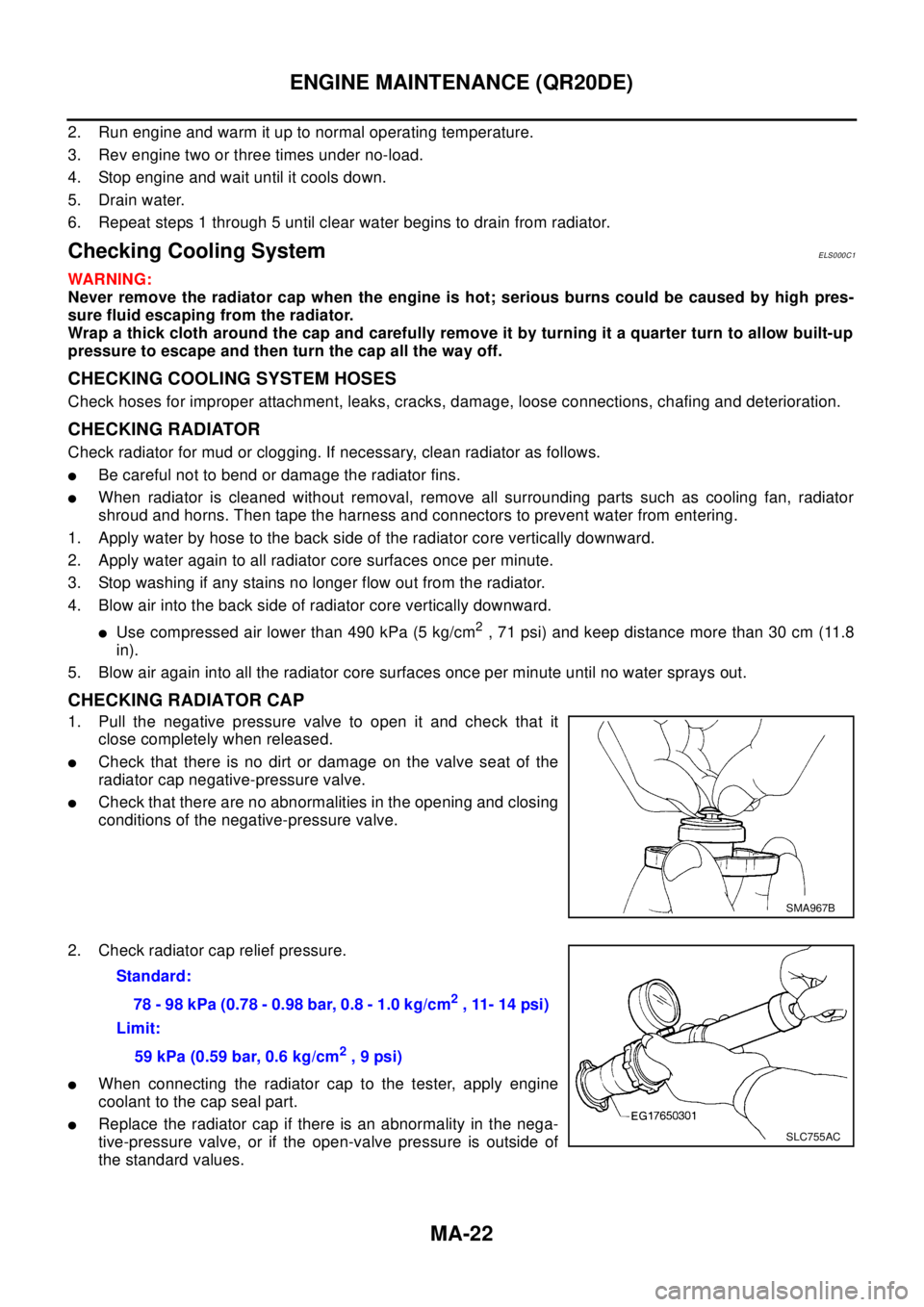
MA-22
ENGINE MAINTENANCE (QR20DE)
2. Run engine and warm it up to normal operating temperature.
3. Rev engine two or three times under no-load.
4. Stop engine and wait until it cools down.
5. Drain water.
6. Repeat steps 1 through 5 until clear water begins to drain from radiator.
Checking Cooling SystemELS000C1
WAR NIN G:
Never remove the radiator cap when the engine is hot; serious burns could be caused by high pres-
sure fluid escaping from the radiator.
Wrap a thick cloth around the cap and carefully remove it by turning it a quarter turn to allow built-up
pressure to escape and then turn the cap all the way off.
CHECKING COOLING SYSTEM HOSES
Check hoses for improper attachment, leaks, cracks, damage, loose connections, chafing and deterioration.
CHECKING RADIATOR
Check radiator for mud or clogging. If necessary, clean radiator as follows.
lBe careful not to bend or damage the radiator fins.
lWhen radiator is cleaned without removal, remove all surrounding parts such as cooling fan, radiator
shroud and horns. Then tape the harness and connectors to prevent water from entering.
1. Apply water by hose to the back side of the radiator core vertically downward.
2. Apply water again to all radiator core surfaces once per minute.
3. Stop washing if any stains no longer flow out from the radiator.
4. Blow air into the back side of radiator core vertically downward.
lUsecompressedairlowerthan490kPa(5kg/cm2, 71 psi) and keep distance more than 30 cm (11.8
in).
5. Blow air again into all the radiator core surfaces once per minute until no water sprays out.
CHECKING RADIATOR CAP
1. Pull the negative pressure valve to open it and check that it
close completely when released.
lCheck that there is no dirt or damage on the valve seat of the
radiator cap negative-pressure valve.
lCheck that there are no abnormalities in the opening and closing
conditions of the negative-pressure valve.
2. Check radiator cap relief pressure.
lWhen connecting the radiator cap to the tester, apply engine
coolant to the cap seal part.
lReplace the radiator cap if there is an abnormality in the nega-
tive-pressure valve, or if the open-valve pressure is outside of
the standard values.
SMA967B
Standard:
78-98kPa(0.78-0.98bar,0.8-1.0kg/cm
2, 11- 14 psi)
Limit:
59 kPa (0.59 bar, 0.6 kg/cm
2,9psi)
SLC755AC
Page 2515 of 3066
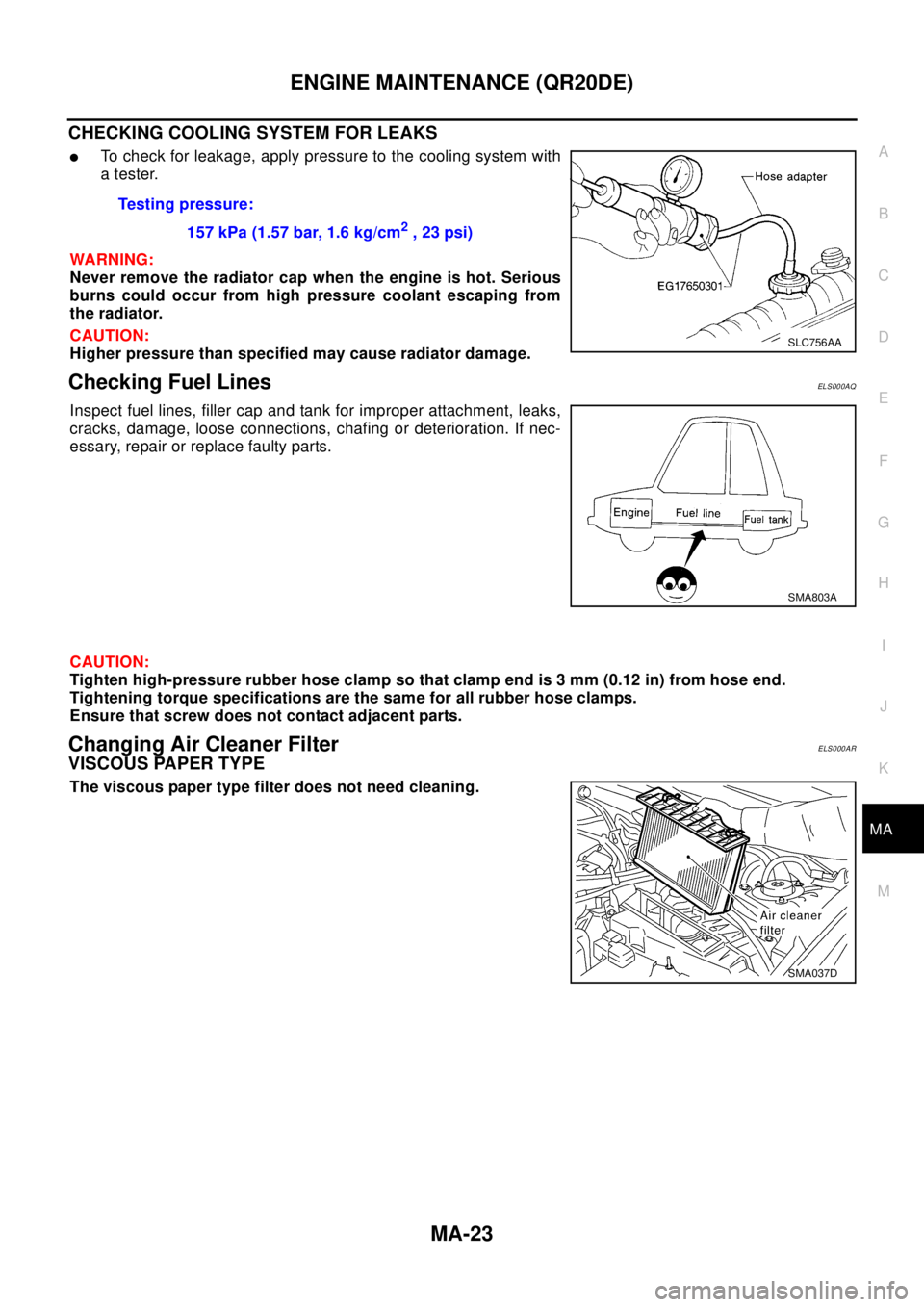
ENGINE MAINTENANCE (QR20DE)
MA-23
C
D
E
F
G
H
I
J
K
MA
B
MA
CHECKING COOLING SYSTEM FOR LEAKS
lTo check for leakage, apply pressure to the cooling system with
atester.
WA RN ING:
Never remove the radiator cap when the engine is hot. Serious
burns could occur from high pressure coolant escaping from
the radiator.
CAUTION:
Higher pressure than specified may cause radiator damage.
Checking Fuel LinesELS000AQ
Inspect fuel lines, filler cap and tank for improper attachment, leaks,
cracks, damage, loose connections, chafing or deterioration. If nec-
essary, repair or replace faulty parts.
CAUTION:
Tighten high-pressure rubber hose clamp so that clamp end is 3 mm (0.12 in) from hose end.
Tightening torque specifications are the same for all rubber hose clamps.
Ensure that screw does not contact adjacent parts.
Changing Air Cleaner FilterELS000AR
VISCOUS PAPER TYPE
The viscous paper type filter does not need cleaning.Testing pressure:
157 kPa (1.57 bar, 1.6 kg/cm
2,23psi)
SLC756AA
SMA803A
SMA037D
Page 2519 of 3066
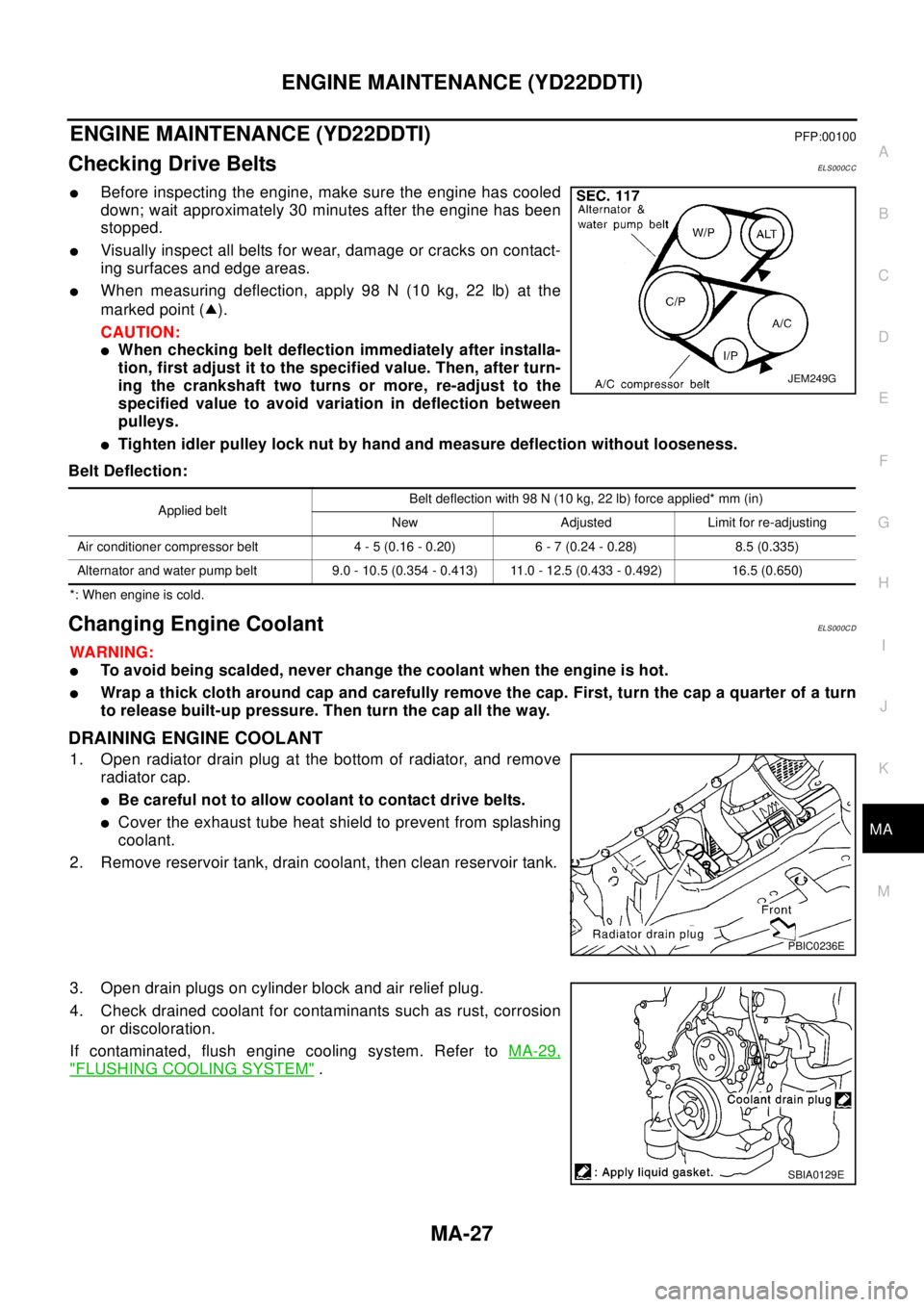
ENGINE MAINTENANCE (YD22DDTI)
MA-27
C
D
E
F
G
H
I
J
K
MA
B
MA
ENGINE MAINTENANCE (YD22DDTI)PFP:00100
Checking Drive BeltsEL S00 0C C
lBefore inspecting the engine, make sure the engine has cooled
down; wait approximately 30 minutes after the engine has been
stopped.
lVisually inspect all belts for wear, damage or cracks on contact-
ing surfaces and edge areas.
lWhen measuring deflection, apply 98 N (10 kg, 22 lb) at the
marked point ( ).
CAUTION:
lWhen checking belt deflection immediately after installa-
tion, first adjust it to the specified value. Then, after turn-
ing the crankshaft two turns or more, re-adjust to the
specified value to avoid variation in deflection between
pulleys.
lTighten idler pulley lock nut by hand and measure deflection without looseness.
Belt Deflection:
*: When engine is cold.
Changing Engine CoolantEL S00 0C D
WA RN ING:
lTo avoid being scalded, never change the coolant when the engine is hot.
lWrap a thick cloth around cap and carefully remove the cap. First, turn the cap a quarter of a turn
to release built-up pressure. Then turn the cap all the way.
DRAINING ENGINE COOLANT
1. Open radiator drain plug at the bottom of radiator, and remove
radiator cap.
lBe careful not to allow coolant to contact drive belts.
lCover the exhaust tube heat shield to prevent from splashing
coolant.
2. Remove reservoir tank, drain coolant, then clean reservoir tank.
3. Open drain plugs on cylinder block and air relief plug.
4. Check drained coolant for contaminants such as rust, corrosion
or discoloration.
If contaminated, flush engine cooling system. Refer toMA-29,
"FLUSHING COOLING SYSTEM".
JEM249G
Applied beltBelt deflection with 98 N (10 kg, 22 lb) force applied* mm (in)
New Adjusted Limit for re-adjusting
Air conditioner compressor belt 4 - 5 (0.16 - 0.20) 6 - 7 (0.24 - 0.28) 8.5 (0.335)
Alternator and water pump belt 9.0 - 10.5 (0.354 - 0.413) 11.0 - 12.5 (0.433 - 0.492) 16.5 (0.650)
PBIC0236E
SBIA0129E
Page 2520 of 3066
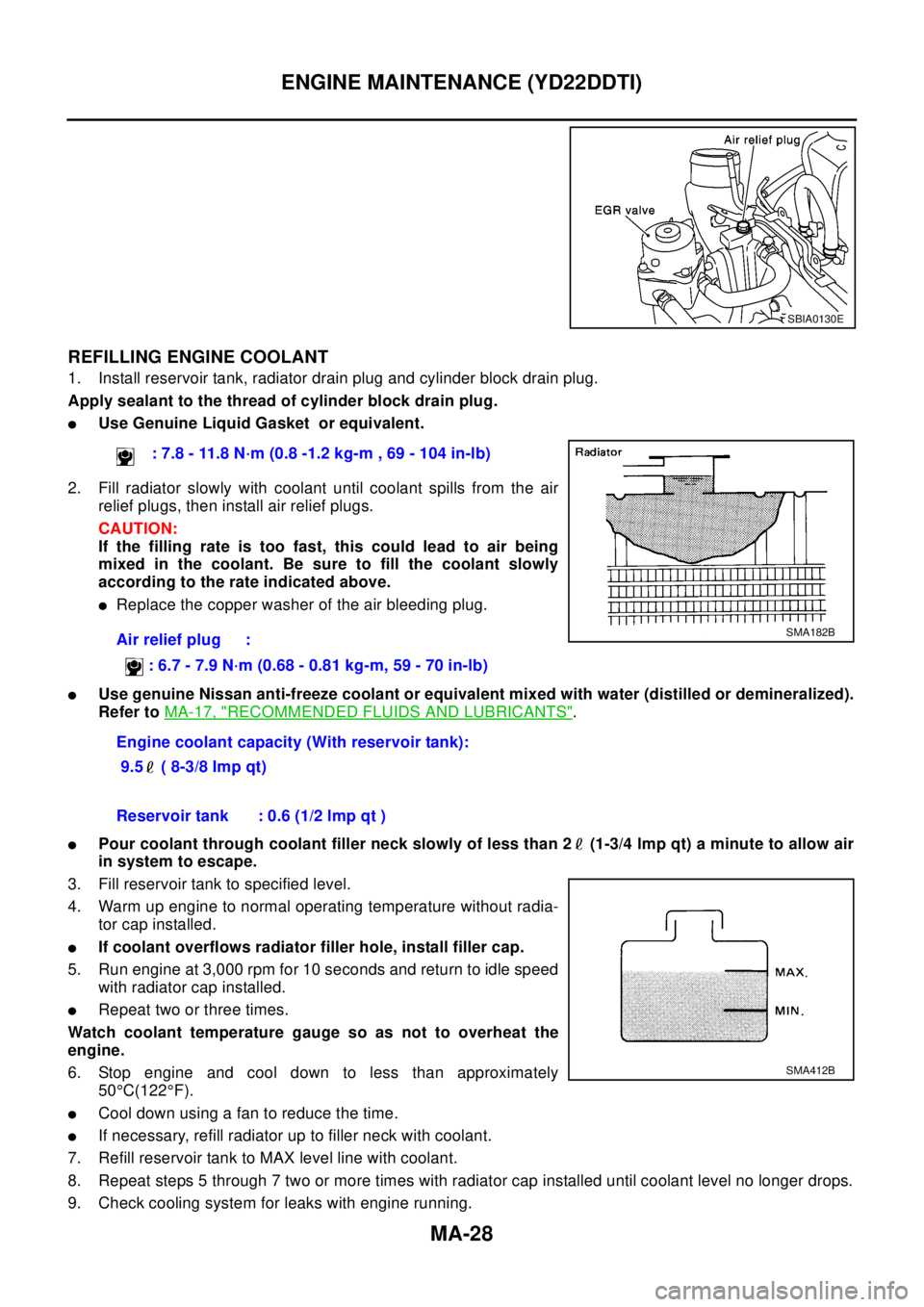
MA-28
ENGINE MAINTENANCE (YD22DDTI)
REFILLING ENGINE COOLANT
1. Install reservoir tank, radiator drain plug and cylinder block drain plug.
Apply sealant to the thread of cylinder block drain plug.
lUse Genuine Liquid Gasket or equivalent.
2. Fill radiator slowly with coolant until coolant spills from the air
relief plugs, then install air relief plugs.
CAUTION:
If the filling rate is too fast, this could lead to air being
mixed in the coolant. Be sure to fill the coolant slowly
according to the rate indicated above.
lReplace the copper washer of the air bleeding plug.
lUse genuine Nissan anti-freeze coolant or equivalent mixed with water (distilled or demineralized).
Refer toMA-17, "
RECOMMENDED FLUIDS AND LUBRICANTS".
lPour coolant through coolant filler neck slowly of less than 2 (1-3/4 lmp qt) a minute to allow air
in system to escape.
3. Fill reservoir tank to specified level.
4. Warm up engine to normal operating temperature without radia-
tor cap installed.
lIf coolant overflows radiator filler hole, install filler cap.
5. Run engine at 3,000 rpm for 10 seconds and return to idle speed
with radiator cap installed.
lRepeat two or three times.
Watch coolant temperature gauge so as not to overheat the
engine.
6. Stop engine and cool down to less than approximately
50°C(122°F).
lCool down using a fan to reduce the time.
lIf necessary, refill radiator up to filler neck with coolant.
7. Refill reservoir tank to MAX level line with coolant.
8. Repeat steps 5 through 7 two or more times with radiator cap installed until coolant level no longer drops.
9. Check cooling system for leaks with engine running.
SBIA0130E
: 7.8 - 11.8 N·m (0.8 -1.2 kg-m , 69 - 104 in-lb)
Air relief plug :
:6.7-7.9N·m(0.68-0.81kg-m,59-70in-lb)
Engine coolant capacity (With reservoir tank):
9.5 ( 8-3/8 Imp qt)
SMA182B
Reservoir tank : 0.6 (1/2 lmp qt )
SMA412B